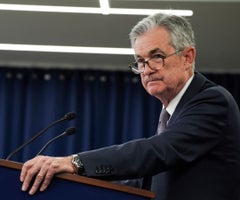MI SELECCIÓN DE NOTICIAS
Noticias personalizadas, de acuerdo a sus temas de interés

By Greg Ip
Asked Wednesday when the Federal Reserve would be done cutting interest rates, Chairman Jerome Powell answered: “When we think we’ve done enough.”
Reminiscent of Supreme Court Justice Potter Stewart’s definition of pornography-“I know it when I see it”-Mr. Powell’s answer was crafted both to convey the imprecision of the task and avoid tying him down with specifics.
Indeed, pressed throughout his press conference on what the Fed would do next, he gave variations of that non-answer. Did the Fed have a “bias” on which way rates would move next? He answered: “We made one decision, to lower the federal-funds rate by a quarter of a percentage point.”
The immediate reason for this studied unhelpfulness is that the principal risk to the economy-a trade war between the U.S. and China-is impossible to forecast. But there is a larger purpose too: talking less about the Fed’s intentions minimizes miscommunication while maximizing flexibility when economic and trade-war developments change.
Many of Mr. Powell’s hardest moments have come from when he sought to elaborate on the Fed’s plans, triggering backlash in the markets: Rates were “a long way from neutral,” balance sheet shrinkage was on “autopilot,” and July’s cut was a “mid-cycle adjustment.” The descriptions weren’t wrong or misleading, but turned Mr. Powell into a target when markets didn’t like the answer, or when events forced him to change course.
Generations ago central bankers avoided scrutiny by saying nothing. “Never explain, never apologize,” was the Bank of England’s unofficial motto. That began to change in the 1990s as the Fed and other central banks decided that explaining what they did and why both delivered accountability, and ensured markets worked with, rather than against, monetary policy.
Transparency morphed into “forward guidance,” such as biases on the central bank’s next move, and eventually broad descriptions, charts and quasi-commitments about the path rates would follow.
Yet there is such a thing as talking too much. If transparency got markets better aligned with the Fed, it also accentuated the damage if markets misunderstood, or if events turned out differently than expected.
Mr. Powell is looking for the right balance between transparency and ambiguity.
He will no doubt return to forward guidance if the course of action is obvious or markets have seriously misread the Fed.
Nor is it possible, or even desirable, to clam up. The public demands much more transparency from the Fed than in the 1980s. Mr. Powell gives eight televised news conferences a year. He and his colleagues give countless speeches and interviews. You can’t talk that much without occasionally saying something you regret (ask Joe Biden ).
Then there is the “dot plot,” the quarterly schematic showing where every member of the Federal Open Market Committee expects rates to be over the next three years. Absent other guidance, markets will assume that is what the Fed will do next.
Mr. Powell’s response Wednesday was to subtly suggest the dot plot be ignored. It didn’t represent “hardened views or a prediction.” Indeed, he returned to the posture he struck at his first press conference, early last year, when he turned aside questions about the dot plot by saying: “We made one decision at this meeting.”
La empresa de asesoramiento ha recibido recientemente el interés de grandes inversores, según dijo el domingo el periódico citando a personas no identificadas
En un comunicado emitido por la Casa Blanca, Biden dijo que “el mundo se sintió inspirado por los millones de venezolanos que votaron valientemente”
La presidente de México aseguró que se está revisando la siembra e importación de maíz transgénico a México por las implicaciones